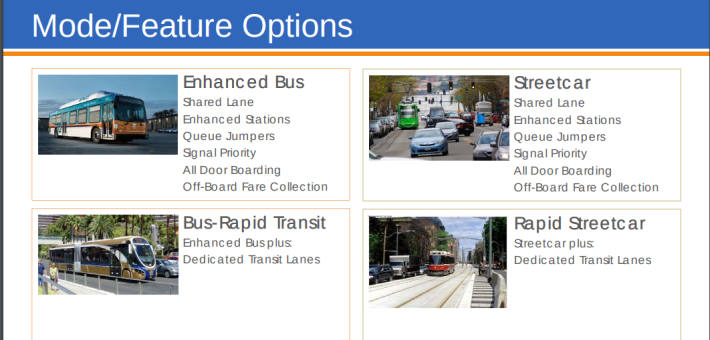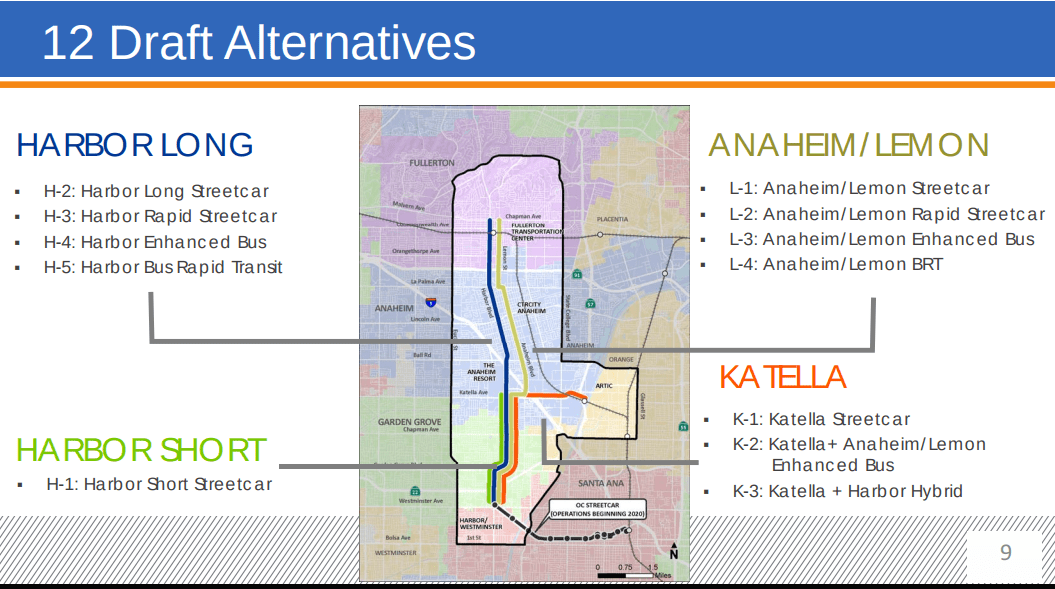The Orange County Transportation Authority has begun a study to find a more efficient transit option for the corridor with the highest transit usage in the county.
The Central Harbor Boulevard Transit Corridor Study will look at bringing a streetcar or more effective bus options to a stretch of Harbor Boulevard that runs through Garden Grove, Anaheim, and Fullerton. The most southern point of the study area would connect with the future OC Streetcar at Westminster Avenue, and the most northern point would connect to the Fullerton Transportation Center. The area under study receives more than 27 million annual visitors, with population and employment densities exceeding Orange County averages.
What's especially unique about this study is OCTA's inclusion of options that would separate transit from general traffic, providing designated lanes for the exclusive use of a bus or streetcar. A Bus Rapid Transit system with its own designated bus lane would be the first of its kind in the county. OCTA currently has express buses and Bravo! routes that offer limited-stop service, but those routes do not have designated lanes to speed bus traffic.
There are twelve iterations of the project that look at different options for travel modes and possible routes. Some of them travel the whole length of the three-city study area, while two corridors' proposals stretch across Garden Grove and Anaheim. One proposal being considered would extend the future OC Streetcar north on Harbor and then east along Katella Avenue to connect to the Anaheim Regional Transportation Intermodal Center, known as ARTIC.
Other proposals include an "enhanced bus" that would share a lane with traffic but add improvements like all-door boarding and a way to pay before getting on the bus. Also being studied is a streetcar that would either mix with traffic or have its own designated travel lane.
The BRT and the rapid streetcar options would have at least half their routes separate from general traffic. How much of the entire route would get a fully dedicated lane would be decided based on time savings, costs, right-of-way impacts, and other factors, and would be determined in the environmental process, according to Joel Zlotnik, an OCTA spokesperson.
Alternative routes from Garden Grove to Fullerton include one along Harbor Boulevard and a parallel option on Anaheim Boulevard/Lemon Street. The shortest option being studied would extend the OC Streetcar at Harbor Boulevard to around Katella Avenue, which would bring it closer to the Anaheim Resort district, where Disneyland and the Anaheim Convention Center are located.
A hybrid option connecting to ARTIC is also on the table, and that would extend the OC Streetcar on Harbor to Katella Avenue and add an "enhanced bus" to connect passengers to ARTIC and Anaheim Resort district.

If one of these streetcar proposals sounds familiar, it's because the idea of connecting ARTIC to the Anaheim Resort district is an attempt to keep the failed Anaheim Regional Connector project alive. The OCTA board of directors pulled funding last year from the 3.2 mile ARC project after concerns were raised over its $300 million price tag and the possibility that ridership would be low.
After ARC funding was pulled, OCTA staff was directed to conduct a study that would look in greater detail at the Harbor area under study and include the east-west ARC route.
A backlash from one of the cities in the Harbor study area already threatens the streetcar options. The City of Anaheim passed a resolution last month opposing any streetcar project on the former ARC route or any streetcar along Harbor Boulevard.
Todd Spitzer, OCTA board member and County Supervisor, questioned the study's motives at Monday's OCTA board meeting. "We’re still studying streetcar and rapid streetcar in light of the fact that a major city going through the middle of the corridor is absolutely against it," he said. "Why are we not reevaluating. . . in light of the recent action of the city of Anaheim? We're spending a lot of money on studying modes that I don't think have any support."
OCTA CEO Darrell Johnson said the Anaheim City Council resolution was premature. The process will take 48 months before any decision will be made on the project, Johnson said, and Anaheim's resolution doesn't take into account the expected outreach and research that would be part of the study.
Spitzer followed up by asking if OCTA could use eminent domain as an option to move the project forward if Anaheim continues to oppose it. OCTA Assistant General Counsel James Donich said that eminent domain is an option but one that he didn't recommend.
The public will get a chance to give their feedback in the next couple of months. OCTA staff will be hosting public workshops in Garden Grove on March 30 and in Anaheim on April 5. The public can also submit comments online or request that an OCTA representative speak to a group.






